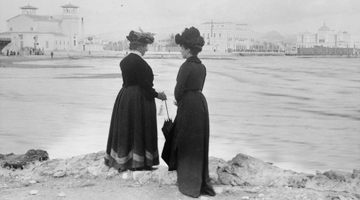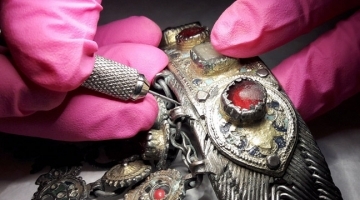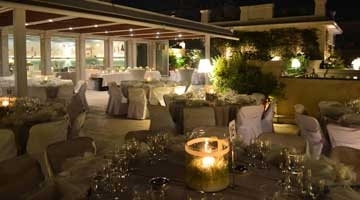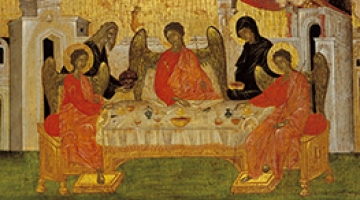- EN English
- Login
-
 EXHIBITION
EXHIBITION
 GUIDED TOURS
GUIDED TOURS
In 1930, after passing the entrance examinations, he enrolled in the École Supérieure des Beaux-Arts in Paris. Concurrently he also entered the Paris Law School where he studied for two years. Between 1930 and 1932, he was a student at the atelier of Professor Jean Boucher. He then rented his own studio, where he remained until 1939. He continued his studies at the École Supérieure des Beaux-Arts and at the School library, the Museum of Casts and the Louvre, and exhibited at the Salon d’ Automne.
Between 1935 and 1938 his output included the bust of painter Andreas Vourloumis, a full-length statue of sculptor Christos Kapralos and a full-length statue of painter Yannis Moralis. In 1937 he was awarded the gold medal at the Paris International Exposition. In 1939 he completed his model for a full-sized statue of Adamantios Korais and exhibited it in Paris. He returned to Greece in order to fulfil his military obligations. He completed his statue of Adamantios Korais in marble - commissioned for the island of Chios.
In 1940 he was awarded the Sculpture Medal in the last Pan-Hellenic Exhibition before the war. On October 28th he was called up and served at the front lines with the rank of private. In April 1941 he returned from the front. During the years of Occupation he worked, as best he could, at his studio in the district of Zographou.
In December 1944 he enlisted in the Greek Royal Navy and served as a sailor in the Alexandria Naval High Command. He remained in Alexandria until 1951, studying the monuments of Egyptian art in Cairo and Upper Egypt. In 1949 he crafted a bronze statue of an athlete for the community stadium of Alexandria (Greek Consulate in Alexandria). In 1950 he had his first one-man exhibition in Alexandria and between 1950 and 1951 crafted a bronze memorial statue of philanthropist Mikes Salvagos for the Greek School of Commerce of Alexandria.
In 1952 he returned to Athens, where in 1953 he was elected professor of the Sculpture Workshops at the Athens School of Fine Arts. In 1954 he became Vice Director of the School for a term of two years. In 1955 he was commissioned to sculpt the memorial to Baron Tossizza for the town of Metsovo, as well four herm columns for the estate of Philippos Argentis on Chios. Between 1957 and 1959 he sculpted the Memorial to the Fallen for the village of Neochori on Chios, a statue of Petros Protopapadakis for the island of Naxos and the monument for Stephanos Delta for the Athens College.
From 1959 to 1969 he served five consecutive two-year terms as Director of the Athens School of Fine Arts. During this period the School developed into a model Institution. The central building of the School was renovated, as well as its underground areas, where the Applied Workshops were established. Workshops were inaugurated for Portable Icons, Art and Mosaics, Decoration and Stage Design, Ceramics, Plaster Technique, Bronze Casting and Engraving, Typography and the Art of the Book. A library room was established. The artistic branches at Delphi, Hydra, Mykonos and Rhodes were renovated, and a branch began operating at Methymne on Lesvos.
In 1960 Pappas held a one-man exhibition of Paintings at the "Armos" Gallery. He crafted the statue of philanthropist Afentakis for the island of Kimolos. Following a Pan-Hellenic competition he was commissioned to sculpt of a full-size memorial statue of Eleftherios Venizelos for Athens. In 1961 he held an outdoor Sculpture exhibition (Doxiades Technological Institute). In 1962-63, after winning the competition, he was awarded the commission to create a statue of Eleftherios Venizelos for the city of Herakleion, Crete. In 1964 he sculpted the statue of Loukis Akritas for the town of Morfou in Cyprus and one of Alexandros Papanastasiou for the Aristotle University of Thessaloniki. Between 1966-67, Pappas sculpted a relief pediment frieze for the façade of a building on Panepistimiou Street, the statue of Nikolaos Plastiras for the town of Tavropos, Karditsa, as well as a statue of an athlete for the Greek Community of Antafagasta, Chile.
Between 1968 and 1974 he crafted the memorial of the Merchant Marine for the town of Ermoupolis on the island of Syros, the bust of Ioannes Sykoutris (for the district of Nea Smyrni) as well as a statue of Archbishop Chrysanthos of Trebizon (for Komotini); and a statue of Liberty for the Stanford University (California). He presented a major exhibition of his painting at the "Ora" Gallery. In 1971 he completed and placed the statue of Eleftherios Venizelos in Athens (Parko Eleftherias – Freedom Park).
In 1972 Pappas was elected corresponding member of the Académie Française.
In 1975-76 he organised an Exhibition of Sculpture and Painting at the Library of the Athens College on the theme of "Children and Youth". He sculpted the bust of Homer Davis for the Athens College, of Andreas Michalakopoulos for the city of Patras, of Achilleas Tzartzanos for the town of Tyrnavos and of Ioannis Kapodistrias for the Panteios School. In 1976 he exhibited his sculpture and drawings at the "Argo" Gallery and sculpted the bust of N. Louros (Alexandras Maternity Clinic).
In 1977 he held an exhibition of paintings on "Views of Aegina" at the "Ora" Gallery. He completed and placed the marble statue of Eleftherios Venizelos in Thessaloniki.
In 1978 he resigned the chair of Sculpture at the Athens School of Fine Arts. The Ministry of Education awarded him the title of Honorary Director of the School. He represented Greece at the Venice Biennale with works of sculpture and painting. In 1979 he crafted a full-size statue of Evangelos Papanoutsos.
In 1980 he was elected a regular member of the Athens Academy.
Between 1981 and 1991 his completed commissions included the following works: A marble statue of Eleftherios Venizelos (in the precinct of the Greek Parliament Building), an equestrian statue of Georgios Karaiskakis; a statue of Evangelos Averoff-Tossizzas (for the town of Metsovo); additionally, for the entrance of The Onasseio Cardiology Centre, reliefs of the donors, a monumental epigraph of the Hippocratic Oath and, in the atrium, an eight-metre bronze column with gilt decoration. He also sculpted the statue of Pantelis Prevelakis (for the Rethymno Town Hall) and his grave memorial at the chapel of Saint John in Rethymno; a statue of General Makrigiannis (in the district of Makrigianni); a statue of Ion Dragoumis (Makedonomachon Square, Thessaloniki); a statue of Odysseus Elytis (Dexameni Square); a statue of Charilaos Trikoupis (for the precinct of the Greek Parliament Building).
In 1992 the National Gallery organised a retrospective of his work. Also taking place simultaneously were an exhibition of his drawings and smaller sculptures and an exhibition entitled "The workshop and a model" at "Gallerie 3".
In May 1999 he held an exhibition of his paintings at the Benaki Museum, where, during the same year he contributed to the exhibition of Fayum-inspired portraits.
He has translated writings by painters and sculptors from the original English, French and Italian into Greek; they are included in the publication "Κείμενα για την Τέχνη" ("Writing on Art") (Nefeli Editions, Athens 1993), as well as poems, prose and essays: F. Nietzsche, "Κείμενα" ("Writings"), (Athens 1998), L. Pirandello, "Δεκαεπτά Διηγήματα" ("Seventeen Short Stories") (Σύλλογος προς Διάδοσιν Ωφελίμων Βιβλίων – The Association for the Promotion of Useful Books, Athens 2000), and Italo Svevo, "Μια φάρσα επιτυχημένη" ("A Successful Prank") (short stories, Poreia Editions).
Other works include: "Σχέδια και ζωγραφική του Χειρουργού Αλέξανδρου Παππά" ("Drawings and painting by Surgeon Alexandros Pappas") (Athens 1983); "Κείμενα" ("Writings") (The Educational Foundation of the National Bank of Greece, Athens 1994); "Μικρή συλλογή" ("A small collection") (Athens 1999) and three illustrated volumes with his entire artistic oeuvre: "Σχέδια, 1930-1965" ("Drawings, 1930-1965") (Athens 1990); "Ζωγραφική" ("Painting") (L. Braggioti Editions, Athens 1998), and "Γλυπτική" ("Sculpture") (Adam Publications).
This text is reprinted from the catalogue to the exhibition "Είκοσι τέσσερις γλύπτες τιμούν τον δάσκαλό τους. Αφιέρωμα στον γλύπτη Γιάννη Παππά" ("Twenty-four sculptors honour their teacher. An exhibition dedicated to sculptor Yannis Pappas"), The Educational Foundation of the National Bank of Greece, The Eynardos Mansion, April 3rd-May 7th 2002, Athens 2002.
In 1922 he went to Paris, taking lessons in painting and drawing from R. Bissière and D. Galanis at the Académie Ranson, while studying French literature and Aesthetics at the Sorbonne.
He first exhibited his work in Paris in 1923, at the Salon des Tuileries and the Salon des Surindépendants, and afterwards contributed to many group exhibitions.
His first one-man exhibition took place at the Galerie Percier in Paris in 1927. His first exhibition in Athens, held at the Strategopoulos Gallery in 1928, was shared with sculptor Michael Tombros.
In 1934, already a respected artist, he decided to leave Paris in order to settle in Athens. Between 1935 and 1937 he edited the periodical "To Trito Mati" ("The Third Eye") together with architect Pikionis, the poet Papatzonis and the director Karantinos.
In 1937 he restored the ancestral home of the Ghikas family in Hydra, where he painted the first works in which he expressed his artistic style decisively, combining the elements of Cubism with the nature, light and architecture of Greece.
He was appointed Professor of Drawing at the National Technical University of Athens School of Architecture in 1941, and continued to teach there until 1958.
In 1972 he was elected a regular member of the Academy of Athens and in 1986 an honorary member of the Royal Academy of Arts in London. He was also granted honorary doctorates by the School of Architecture at the University of Thessaloniki in 1982 and by the University of Athens School of Philosophy in 1991.
More than fifty exhibitions of Hadjikyriakos-Ghika’s works were held over the years in Athens, Paris, London, Geneva, Berlin and New York.
Examples of his work are to be found in many private collections in Greece, Western Europe and the USA, as well as in the Musée d’Art Moderne in Paris, the Tate Gallery in London, the Metropolitan Museum of Art in New York, the National Gallery in Athens, and many other museums.
Apart from painting, drawing and sculpture, Hadjikyriakos-Ghika was also involved in designing stage sets and costumes for theatrical works such as Aristophanes’ "Clouds" (National Theatre of Greece, 1951; Comédie Française, 1952) and Gide’s ballet "Persephone", with music by Stravinsky (Covent Garden, 1961). He also illustrated a number of books, including N. Kazantzakis’ "Odyssey", Longos’ "Daphne and Chloe" and C.P. Cavafy’s "Poems". His writings include several books, studies and articles on architecture and aesthetics, as well as treatises on Greek art.
Nikos Hadjikyriakos-Ghikas died on 3 September 1994.
Benakis began his career as a collector in Alexandria, gradually reaching the decision to donate his collections to the Greek state, an idea which became reality after he settled permanently in Athens in 1926.
The world in which Antonis Benakis moved was shaped in a period when the drive to extend the boundaries of the Greek state was as much an element of contemporary society as the parallel ideologies of urban development and enlightenment through education. Benakis' proverbial generosity towards other cultural institutions and undertakings was indicative of this.
His personality was formed within a family environment which nourished such ideals, and which also fostered the exceptional literary talents of his sister, Penelope Delta (1874-1941), whose stories have been familiar to generations of Greek children.
It is certain that Antonis Benakis, the founder of the Benaki Museum, was also influenced by the example of his father Emmanuel Benakis (1843-1929). A close friend and colleague of the great statesman Eleftherios Venizelos (1864-1936), Emmanuel Benakis placed his fortune at the disposal of numerous charitable foundations and likewise contributed to the settlement of refugees in the aftermath of the catastrophe in Asia Minor.
Within this context, the nature of Antonis Benakis’s benefaction becomes self-evident. Its most salient feature remains the fact that during his own lifetime Benakis donated the museum he created to the Greek state. Of equal importance was his continuous involvement, until his death in 1954, in enriching and improving the organisation of the museum’s holdings, and his role in ensuring its financial security.
Page 1 of 2




